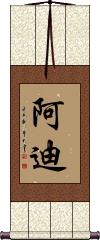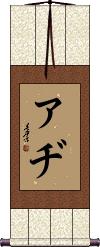Many custom options...
And formats...

The name Adi in Chinese / Japanese...
Buy an Adi calligraphy wall scroll here!
Personalize your custom “Adi” project by clicking the button next to your favorite “Adi” title below...
Not the results for adi that you were looking for?
Below are some entries from our dictionary that may match your adi search...
| Characters If shown, 2nd row is Simp. Chinese |
Pronunciation Romanization |
Simple Dictionary Definition | ||||||||||||||||||||||||||||||||||||||||||||||||||||||||||||
佛 see styles |
fó fo2 fo hotoke ほとけ |
More info & calligraphy: Buddhism / Buddha(surname) Hotoke Buddha, from budh to "be aware of", "conceive", "observe", "wake"; also 佛陀; 浮圖; 浮陀; 浮頭; 浮塔; 勃陀; 勃馱; 沒馱; 母馱; 母陀; 部陀; 休屠. Buddha means "completely conscious, enlightened", and came to mean the enlightener. he Chinese translation is 覺 to perceive, aware, awake; and 智 gnosis, knowledge. There is an Eternal Buddha, see e.g. the Lotus Sutra, cap. 16, and multitudes of Buddhas, but the personality of a Supreme Buddha, an Ādi-Buddha, is not defined. Buddha is in and through all things, and some schools are definitely Pan-Buddhist in the pantheistic sense. In the triratna 三寳 commonly known as 三寳佛, while Śākyamuni Buddha is the first "person" of the Trinity, his Law the second, and the Order the third, all three by some are accounted as manifestations of the All-Buddha. As Śākyamuni, the title indicates him as the last of the line of Buddhas who have appeared in this world, Maitreya is to be the next. As such he is the one who has achieved enlightenment, having discovered the essential evil of existence (some say mundane existence, others all existence), and the way of deliverance from the constant round of reincarnations; this way is through the moral life into nirvana, by means of self-abnegation, the monastic life, and meditation. By this method a Buddha, or enlightened one, himself obtains Supreme Enlightenment, or Omniscience, and according to Māhāyanism leads all beings into the same enlightenment. He sees things not as they seem in their phenomenal but in their noumenal aspects, as they really are. The term is also applied to those who understand the chain of causality (twelve nidānas) and have attained enlightenment surpassing that of the arhat. Four types of the Buddha are referred to: (1) 三藏佛the Buddha of the Tripiṭaka who attained enlightenment on the bare ground under the bodhi-tree; (2) 通佛the Buddha on the deva robe under the bodhi-tree of the seven precious things; (3) 別佛the Buddha on the great precious Lotus throne under the Lotus realm bodhi-tree; and (4) 圓佛the Buddha on the throne of Space in the realm of eternal rest and glory where he is Vairocana. The Hīnayāna only admits the existence of one Buddha at a time; Mahāyāna claims the existence of many Buddhas at one and the same time, as many Buddhas as there are Buddha-universes, which are infinite in number. |
||||||||||||||||||||||||||||||||||||||||||||||||||||||||||||
アディ see styles |
adi アディ |
More info & calligraphy: Addi |
||||||||||||||||||||||||||||||||||||||||||||||||||||||||||||
アーティ see styles |
aadi / adi アーディ |
More info & calligraphy: Arti |
||||||||||||||||||||||||||||||||||||||||||||||||||||||||||||
不生 see styles |
bù shēng bu4 sheng1 pu sheng fushou / fusho ふしょう |
(place-name) Fushou anutpatti; anutpāda. Non-birth: not to be reborn, exempt from rebirth; arhan is mistakenly interpreted as 'not born', meaning not born again into mortal worlds. The 'nir' in nirvana is also erroneously said to mean 'not born'; certain schools say that nothing ever has been born, or created, for all is eternal. The Shingon word 'a' is interpreted as symbolizing the uncreated. The unborn or uncreated is a name for the Tathāgata, who is not born, but eternal ; hence by implication the term means "eternal". ādi, which means"at first, " "beginning","primary", is also interpreted as 不生 uncreated. |
||||||||||||||||||||||||||||||||||||||||||||||||||||||||||||
佛刹 see styles |
fó chà fo2 cha4 fo ch`a fo cha bussetsu |
buddhakṣetra. 佛紇差怛羅 Buddha realm, land or country; see also 佛土, 佛國. The term is absent from Hīnayāna. In Mahāyāna it is the spiritual realm acquired by one who reaches perfect enlightenment, where he instructs all beings born there, preparing them for enlightenment. In the schools where Mahāyāna adopted an Ādi-Buddha, these realms or Buddha-fields interpenetrated each other, since they were coexistent with the universe. There are two classes of Buddhakṣetra: (1) in the Vairocana Schools, regarded as the regions of progress for the righteous after death; (2) in the Amitābha Schools, regarded as the Pure Land; v. McGovern, A Manual of Buddhist Philosophy, pp. 70-2. | ||||||||||||||||||||||||||||||||||||||||||||||||||||||||||||
大乘 see styles |
dà shèng da4 sheng4 ta sheng oonori おおのり |
Mahayana, the Great Vehicle; Buddhism based on the Mayahana sutras, as spread to Central Asia, China and beyond; also pr. [Da4 cheng2] (surname) Oonori Mahāyāna; also called 上乘; 妙乘; 勝乘; 無上乘; 無上上乘; 不惡乘; 無等乘, 無等等乘; 摩訶衍 The great yāna, wain, or conveyance, or the greater vehicle in comparison with the 小乘 Hīnayāna. It indicates universalism, or Salvation for all, for all are Buddha and will attain bodhi. It is the form of Buddhism prevalent in Tibet, Mongolia, China, Korea, Japan, and in other places in the Far East. It is also called Northern Buddhism. It is interpreted as 大教 the greater teaching as compared with 小教 the smaller, or inferior. Hīnayāna, which is undoubtedly nearer to the original teaching of the Buddha, is unfairly described as an endeavour to seek nirvana through an ash-covered body, an extinguished intellect, and solitariness; its followers are sravakas and pratyekabuddhas (i.e. those who are striving for their own deliverance through ascetic works). Mahāyāna, on the other hand, is described as seeking to find and extend all knowledge, and, in certain schools, to lead all to Buddhahood. It has a conception of an Eternal Buddha, or Buddhahood as Eternal (Adi-Buddha), but its especial doctrines are, inter alia, (a) the bodhisattvas 菩薩 , i.e. beings who deny themselves final Nirvana until, according to their vows, they have first saved all the living; (b) salvation by faith in, or invocation of the Buddhas or bodhisattvas; (c) Paradise as a nirvana of bliss in the company of Buddhas, bodhisattvas, saints, and believers. Hīnayāna is sometimes described as 自利 self-benefiting, and Mahāyāna as 自利利他 self-benefit for the benefit of others, unlimited altruism and pity being the theory of Mahāyāna. There is a further division into one-yana and three-yanas: the trīyāna may be śrāvaka, pratyeka-buddha, and bodhisattva, represented by a goat, deer, or bullock cart; the one-yāna is that represented by the Lotus School as the one doctrine of the Buddha, which had been variously taught by him according to the capacity of his hearers, v. 方便. Though Mahāyāna tendencies are seen in later forms of the older Buddhism, the foundation of Mahāyāna has been attributed to Nāgārjuna 龍樹. "The characteristics of this system are an excess of transcendental speculation tending to abstract nihilism, and the substitution of fanciful degrees of meditation and contemplation (v. Samādhi and Dhyāna) in place of the practical asceticism of the Hīnayāna school."[Eitel 68-9.] Two of its foundation books are the 起信論and the 妙法蓮華經 but a larnge numberof Mahāyāna sutras are ascribed to the Buddha。. |
||||||||||||||||||||||||||||||||||||||||||||||||||||||||||||
アジ島 see styles |
ajitou / ajito アジとう |
(place-name) Adi (island) | ||||||||||||||||||||||||||||||||||||||||||||||||||||||||||||
本初佛 see styles |
běn chū fó ben3 chu1 fo2 pen ch`u fo pen chu fo Honshobutsu |
Ādibuddha; Ādi-Buddha | ||||||||||||||||||||||||||||||||||||||||||||||||||||||||||||
五智如來 五智如来 see styles |
wǔ zhì rú lái wu3 zhi4 ru2 lai2 wu chih ju lai gochi nyorai |
五智五佛; 五佛; 五如來 The five Dhyāni-Buddhas, or Wisdom-Tathāgatas of the Vajradhātu 金剛界, idealizations of five aspects of wisdom; possibly of Nepalese origin. The Wisdom Buddha represents the dharmakāya or Buddha-mind, also the Dharma of the triratna, or trinity. Each evolves one of the five colours, one of the five senses, a Dhyani-bodhisattva in two forms onegracious, the other fierce, and a Mānuṣi-Buddha; each has his own śakti, i. e. feminine energy or complement; also his own bīja, or germ-sound 種子or 印 seal, i. e. 眞言 real or substantive word, the five being for 大日 aṃ, for 阿閦 hūṃ, for 寶生 ? hrīḥ, for 彌陀 ? aḥ, for 不 空 ? āḥ. The five are also described as the emanations or forms of an Ādi-Buddha, Vajrasattva; the four are considered by others to be emanations or forms of Vairocana as theSupreme Buddha. The five are not always described as the same, e. g. they may be 藥師 (or 王) Bhaiṣajya, 多寶 Prabhūtaratna, Vairocana, Akṣobhya, andeither Amoghasiddhi or Śākyamuni. Below is a classified list of the generally accepted five with certain particulars connected with them, butthese differ in different places, and the list can only be a general guide. As to the Dhyāni-bodhisattvas, each Buddha evolves three forms 五佛生五菩薩, 五金剛, 五忿怒, i. e. (1) a bodhisattva who represents the Buddha's dharmakāya, or spiritual body; (2) a vajra ordiamond form who represents his wisdom in graciousness; and (3) a fierce or angry form, the 明王 who represents his power against evil. (1) Vairocanaappears in the three forms of 轉法輪菩薩 Vajra-pāramitā Bodhisattva, 遍照金剛 Universally Shining Vajrasattva, and 不動明王 Ārya-Acalanātha Rāja; (2) Akṣobhya's three forms are 虛空藏 Ākāśagarbha, 如意 complete power, and 軍荼利明王 Kuṇḍalī-rāja; (3 ) Ratnasaṃbhava's are 普賢 Samantabhadra, 薩埵Sattvavajra, and 孫婆 or 降三世明王 Trailokyavijayarāja; (4) Amitābha's are 觀世音 Avalokiteśvara, 法金剛 Dharmarāja, and 馬頭明王 Hayagrīva, thehorse-head Dharmapāla; (5) Amoghasiddhi's are 彌勒 Maitreya, 業金剛Karmavajra, and 金剛夜叉 Vajrayakṣa. The above Bodhisattvas differ from those in the following list:
Arrival of the five wise Buddhas |
||||||||||||||||||||||||||||||||||||||||||||||||||||||||||||
出世說部 出世说部 see styles |
chū shì shuō bù chu1 shi4 shuo1 bu4 ch`u shih shuo pu chu shih shuo pu Shusse setsu bu |
出世部 (出世間說部) (or 出世語言部) Lokottaravādinaḥ, 盧倶多婆拖部 an offshoot of the Māhāsaṇghikāḥ division of the eighteen Hīnayāna schools; the tenets of the school are unknown, but the name, as implied by the Chinese translation, suggests if not the idea of Ādi-Buddha, yet that of supra-mundane nature. | ||||||||||||||||||||||||||||||||||||||||||||||||||||||||||||
阿提佛陀 see styles |
ā tí fó tuó a1 ti2 fo2 tuo2 a t`i fo t`o a ti fo to Adaibudda |
Ādi-buddha, the primal buddha of ancient Lamaism (Tib. chos-kyi-daṅ-poḥi-saṅs-rgyas); by the older school he is associated with Puxian born of Vairocana i.e. Kuntu-bzan-po, or Dharmakāya-Samantabhadha; by the later school with Vajradhara, or Vajrasattva, who are considered as identical, and spoken of as omniscient, omnipotent, omnipresent, eternal, infinite, uncaused, and causing all things. | ||||||||||||||||||||||||||||||||||||||||||||||||||||||||||||
阿說羅部 阿说罗部 see styles |
ā shuō luó bù a1 shuo1 luo2 bu4 a shuo lo pu Asetsura bu |
aiśvarikas, a theistic school of Nepal, which set up Ādi-Buddha as a supreme divinity. | ||||||||||||||||||||||||||||||||||||||||||||||||||||||||||||
アジウグリ see styles |
ajiuguri アジウグリ |
(place-name) Adi Ugri |
The following table may be helpful for those studying Chinese or Japanese...
| Title | Characters | Romaji (Romanized Japanese) | Various forms of Romanized Chinese | |
| Adi | 阿迪 | ā dí / a1 di2 / a di / adi | a ti / ati | |
| Adi | アヂ | adi | ||
| In some entries above you will see that characters have different versions above and below a line. In these cases, the characters above the line are Traditional Chinese, while the ones below are Simplified Chinese. | ||||
Successful Chinese Character and Japanese Kanji calligraphy searches within the last few hours...





